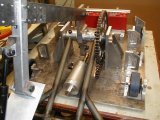
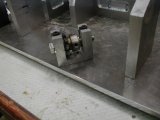

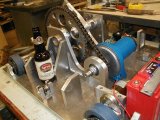
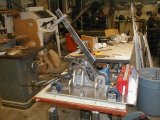
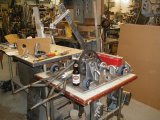
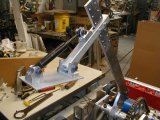

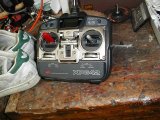
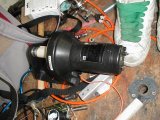
On to Next Page
Back to Front Page
©2000 Derek Young
|
Complete Control - Part 1 The premier of Battlebots series one on Comedy Central had a profound impact orgainzed robot fighting. The first of which was Comedy Central's immediate ordering of another 13 episodes. To produce these shows, another Battlebots competition would have to be run. At this point I decided to build a new robot for the next competition. My previous robot, Pressure Drop, did surprisingly well in the first series, but was never going to be a competitive robot, without a complete overhaul. Instead of beating a dead horse, I went the other way and started with a clean slate. I decided to build a lifting robot. I thought that I could make it both competitive and exciting at the same time. With some inspiration from various other robots: Andrew Lindsey's Spike III, Vlad the Impaler, Evil Fish Tank and World Peace (to name a few), I made some sketches and got to work. The name is from another favorite song of mine: "Complete Control" by the Clash. It turns out to be a triple entendre. See if you can get them all! Anyways, on with the construction. |

|
By the time I started taking pictures, I was already deep into the construction of the robot. As can be seen in this photo, a majority of the components were aluminum, and those parts were all held together with bolts in tapped holes. The base is .3" thick 2024 T351 that I picked up at Boeing Surplus on my vacation I took to Oregon with Gillian in the summer. As you can see in the picture, 33# @ $1.60/#. It all adds up! | |

|
I decided to use chains again to transmit power between axles. This time, it would be between 4 wheels, rather than 6 legs. I decided that untensioned chains are a bad idea, and came up with these little beauties. Not only do they keep the chain tight, they also lift it off of the baseplate. The idler is a 10 tooth 35 pitch sprocket with a pair of 3/8" ID broze bushings pressed into it. | |

|
Thanks to my sponsor, the Pittman motor company, I would be using gearmotors similar to this, with the additional 2:1 output stage. I found out shortly after receiving my gearmotors that the Pittman gearheads are NOT strong enough to withstand ANY use at double voltage. | |

|
Shot of the winch, designed to run the forks in place, with a beer bottle for scale. The holes in the sprocket were done with a hole-saw on a mill. The hub of the sprocket was also turned down to reduce weight. Also shown in the photo are my pair of brand new Hawker PC545 batteries. | |

|
General overview of the robot at this stage. The arm is a strip of the base plate material. The forks are 1" OD 1/16" wall 4130 chromoly tubing that I got from a local custom bike shop. | |

|
Another shot of the forks. I managed to take off two-thirds of the teeth of a 1" hole saw when I was mitering the tubing on the mill. I was dubbed the new "rock 'n roll machinist" of our shop. Thanks to Johnny for TIG'ing them all together. | |

|
The original grabbing foot. Kinda cool, but a bit much. Later into building, when weight became a concern, this was reduced to a simpler unit. The gas spring was $1 at Boeing Surplus. | |

|
Another gratuitous fork, arm and beer bottle shot. The air cylinder is an 2.5" bore American. | |

|
The newly modified radio. I replaced the broken left control stick with a big, fat, red lever. This is to control the forks' position. I also patched this into the elevator channel, so that I could run dual rates on the forks. This allowed me to place them on the ground, or just above the ground. | |

|
My brand new 24V Superwinch X1. Big thanks to Superwinch for being a great sponsor and helping me out by donating such good product. | |
|
On to Next Page Back to Front Page ©2000 Derek Young |